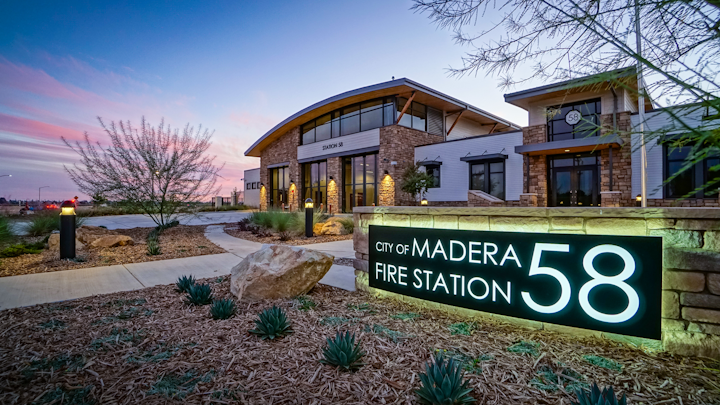
Fire Station 58 in Madera, CA, was not built near a fault line but was designed under the Essential Services Requirements in California.
RRM Design Group
Fire stations in California are not the only stations that need to be designed for potential earthquakes. According to the U.S. Geological Survey, earthquakes can occur anywhere in the world and across North America. While most great earthquakes occur along plate boundaries, the Midwest and East coast are also susceptible, including South Carolina and eastern Massachusetts. Florida and North Dakota are states with the fewest earthquakes.
The USGS reports most earthquakes do not strike randomly but occur in specific areas. One such area is the circum-Pacific Ring of Fire, where the Pacific Plate meets many surrounding tectonic plates. The Ring of Fire is the most seismically and volcanically active zone in the world, and it includes U.S. western states as well as British Columbia.
According to Kimberly Johnston, Principal/Architect for Johnston Davidson Architecture in Vancouver, B.C., designing fire stations in a seismic region can cause crucial design challenges due to the local building codes, which require emergency services projects to meet “post disaster” standards.
“This means that the buildings must withstand 1.5 times the seismic force that a standard building is required to withstand,” said Johnson. “This can impact the type of structure one needs to design, the available materials in which one can build and the challenges of bracing around larger openings, such as apparatus bay doors. These design decisions can have a huge impact on the flow of emergency personnel through the building and the health and wellness of the suppression teams if not properly addressed.”
Johnson explained that if the ground condition is not ideal for bearing, and prone to liquefaction under seismic conditions, then a non-standard foundation design would be required to help ensure the building can be operational when a seismic event occurs.
“This can impact the layout of services coming into the building, the way the building is tied to the foundation and can have a dramatic impact on cost. A similar condition is found with the super structure of the building,” she said.
California-based RRM Design Group Project Manager Michael L. Scott, and in-house Structural Engineer Michael Doremus, explained earthquakes are always a key consideration for any building in California, but especially critical for fire stations since they are classified as essential facilities, according to the International Building Code (IBC--as adopted into the California Building Code, CBC). This means that they need to be operational particularly in response to disasters such as an earthquake.
“The station, designed by a structural engineer, is required to be designed with an importance factor of 1.5 (in lieu of the 1.0 for a standard building), to what is called a “Maximum Considered Earthquake” or MCE level event, an earthquake projected to occur once every 2,500 years,” said Doremus. “What has changed recently for the design of essential buildings, like fire stations, is the release of ASCE 7-16, Minimum Design Loads and Associated Criteria for Buildings and Other Structures…the loading standard for most all loading types including seismic loading.”
“The key takeaway for fire departments and public officials of these changes is that it is now more critical than ever to start the conversation between your geotechnical engineer and your structural engineer early in the process of the design of any new station or building addition/modification," Doremus added. "The code may require a site-specific ground motion study for your station by the geotechnical engineer. This is more involved than what is traditionally provided using mapped values for a site in a geotechnical report under former codes, it can have critical implications on the design of your building and should be evaluated by your structural engineer and geotechnical engineer.”
Both Johnson and Doremus agree it is important for a fire department to have an experienced design team that identifies seismic requirements early for their facility as it will affect cost and viability of the project on a particular site.
Scott said RRM recently designed a fire station in the high seismic zone F. This, plus the conditions of the local geology, resulted in an increased foundation system that is a thickened “mat slab” that help the whole facility to react as one mass in relation to ground movement. This increases the cost of the foundation of the project but allows the fire station to be standing when other buildings in the area have failed or are unsafe.
Verification of local fault locations is another major consideration of vital importance to any fire department looking to purchase land for a fire station in a seismic area. Because a fire station in not allowed to be constructed on an active fault and distances and evaluations of active and non-faults require reports from a geologist, analysis of a site for known faults help the fire departments either rule out specific sites or identify risks and strategies to respond to those risks.
Doremus cautioned, “The questions of fault locations are a go/no go for any site and every fire department looking to place a new fire station in a high seismic zone should make identifying faults a top priority.”
Johnson summed up the topic of earthquakes and fire station design. “As architects, the challenges we face often focus on combining these seismic requirements with the functionality and character that fire departments require,” she said. “It is an exciting challenge, and one which we strive to find unique ways to solve with every project.”
"occur" - Google News
December 22, 2020 at 10:49PM
https://ift.tt/37H6bmP
What's Shaking in Fire Stations? | Firehouse - Firehouse.com
"occur" - Google News
https://ift.tt/2UoDqVw
https://ift.tt/2Wq6qvt
Bagikan Berita Ini
















0 Response to "What's Shaking in Fire Stations? | Firehouse - Firehouse.com"
Post a Comment